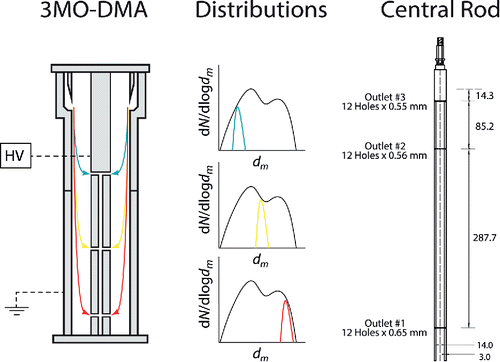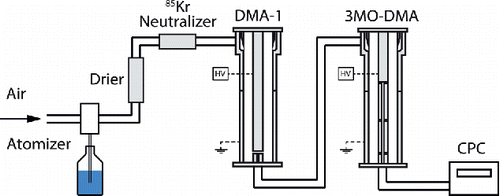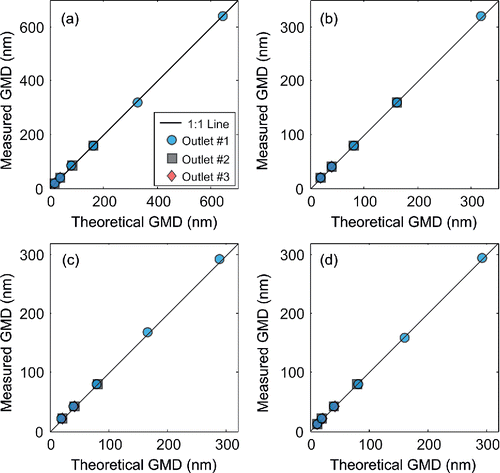Figures & data
Figure 1. Schematic diagram of the 3MO-DMA, showing its operating principle and details of the design (see Table 1 for additional details).

Figure 2. Experimental setup for determining the resolution of the 3MO-DMA at different operating conditions.

Table 1. Characteristic dimensions of all the DMAs used in this work.
Table 2. Ratio between measured and predicted resolutions of each outlet of the 3MO-DMA at the diffusive () and the non-diffusive (
) limit, when operated at different flow conditions (Equations (Equation11
[11] ) and (Equation13
[13] )).
Figure 3. Measured and predicted (without and with considering broadening parameters, i.e., using Equations (Equation7[7] ) and (Equation8
[8] ), respectively) response of the 3MO-DMA coupled with the CPC, when using 40-nm monodisperse ammonium sulfate particles.
![Figure 3. Measured and predicted (without and with considering broadening parameters, i.e., using Equations (Equation7[7] ) and (Equation8[8] ), respectively) response of the 3MO-DMA coupled with the CPC, when using 40-nm monodisperse ammonium sulfate particles.](/cms/asset/035f40b6-8c05-44d9-9ceb-2958ab4538cd/uast_a_1227060_f0003_oc.gif)
Figure 4. Measured vs. theoretically predicted geometrical mean diameters (GMD) of particles classified through each outlet of the 3MO-DMA, when operated with sheath to aerosol flow ratios of 3 lpm/0.3 lpm (a), 6 lpm/0.6 lpm (b), 8 lpm/0.3 lpm (c), and 8 lpm/1.5 lpm (d).

Figure 5. Resolution (1/FWHM) of each outlet of the 3MO-DMA, when operated with sheath-to-aerosol flow ratios of 3.0 lpm/0.3 lpm (a), 6.0 lpm/0.6 lpm (b), 8.0 lpm/0.3 lpm (c), and 8.0 lpm/1.5 lpm (d). The resolutions were estimated by convoluting the transfer functions of the DMAs used in the experimental setup (), using fitted adjustable broadening parameters (i.e., ) for the 3MO-DMA transfer function (i.e., Equations (Equation8
[8] ) and (Equation9
[9] )) to match the experimental size distributions (Section 2.2.2 and ). The theoretical resolutions (dashed lines) of each monodisperse outlet of the 3MO-DMA are determined using Equation (Equation7
[7] ). Fitted resolutions are determined by Equation (Equation8
[8] ) using the median values of the broadening parameters obtained from each data set (i.e., corresponding to the different sheath/aerosol flow rate ratios).
![Figure 5. Resolution (1/FWHM) of each outlet of the 3MO-DMA, when operated with sheath-to-aerosol flow ratios of 3.0 lpm/0.3 lpm (a), 6.0 lpm/0.6 lpm (b), 8.0 lpm/0.3 lpm (c), and 8.0 lpm/1.5 lpm (d). The resolutions were estimated by convoluting the transfer functions of the DMAs used in the experimental setup (Figure 2), using fitted adjustable broadening parameters (i.e., ) for the 3MO-DMA transfer function (i.e., Equations (Equation8[8] ) and (Equation9[9] )) to match the experimental size distributions (Section 2.2.2 and Figure 3). The theoretical resolutions (dashed lines) of each monodisperse outlet of the 3MO-DMA are determined using Equation (Equation7[7] ). Fitted resolutions are determined by Equation (Equation8[8] ) using the median values of the broadening parameters obtained from each data set (i.e., corresponding to the different sheath/aerosol flow rate ratios).](/cms/asset/1ea1fb3e-9f85-4e6b-88ba-9d17fb54b460/uast_a_1227060_f0005_oc.gif)
